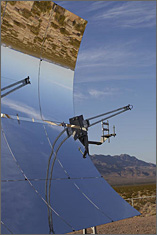
The Solar Energy Technologies Program focuses on concentrating solar power as one of it's primary R&D areas.
The Solar Energy Technologies Program works to develop cost-competitive solar energy systems for America. We spend nearly $150 million per year in research and development (R&D) on two solar electric technologies with the greatest potential to reach cost competitiveness by 2015: photovoltaics (PV) and concentrating solar power (CSP). The greatest R&D challenges are reducing costs and finding new ways to generate and store energy captured from the sun.
The Solar Program also makes sure new technology is accepted in the marketplace. We work to remove many non-technical market barriers, such as updating codes and standards that aren't applicable to new technologies, improving interconnection agreements among utilities and consumers, and analyzing utility value capacity credits for utilities. Such activities help consumers, businesses, and utilities to make more informed decisions when considering renewable energy, and they also facilitate the purchase of solar energy.
Key Activities
The Solar Program has four key activities:
- Technology Pathway Partnerships—Public-private research and development partnerships with industry, universities, laboratories, and state groups designed to achieve solar cost competitiveness by 2015.
- Advanced Photovoltaics Research—Development of photovoltaic technologies with potential for dramatic cost reductions beyond 2015 with performance and reliability improvements.
- Market Transformation—Contracts funded through the Solar America Initiative designed to minimize market barriers and seize market-expansion opportunities.
- Concentrating Solar Power Research—Development of next-generation concentrators, solar engines, and receivers with improved thermal storage. We also provide technical support to industry.

The Moscone Convention Center in downtown San Francisco has 30,000 square feet of PV panels on its roof. This is the first project resulting from two voter initiatives to finance renewable energy in the city's commercial, residential, and government-owned buildings.
Benefits to the Nation
The Solar Program benefits the nation by improving our air quality, developing our economy, and increasing our energy security. Benefits include:
- Increasing energy reliability and security by domestic production of a solar energy supply, which promotes economic growth
- Adding 250,000 new jobs for America in the solar industry
- Saving $100 billion per year for industry and businesses by averting power outages
- Improving air quality, especially for children and the elderly, by using a clean, non-polluting fuel source
- Reducing carbon emissions by 23 million metric tons per year by 2030.
The success of our work will make solar energy accessible to the average consumer because of reduced costs. We will also see utility-scale solar power plants and a booming U.S. solar industry that exports products around the world.
Our Partners
The Solar Energy Technologies Program works with national laboratories and universities to perform research and development and support program management. Our laboratory partners include the National Renewable Energy Laboratory, Sandia National Laboratories, Oak Ridge National Laboratory, and Brookhaven National Laboratory. These laboratories are organized into virtual labs that foster cooperation, communication, and teamwork among all the laboratories. The National Center for Photovoltaics (NCPV) is the PV virtual lab and SunLab is the virtual lab for CSP.
The following documents are available as Adobe Acrobat PDFs. Download Adobe Reader.
For more information, read the following publications:

Solar Energy Technologies Program - Multi-Year Program Plan 2008-2012 (PDF 3.2 MB)

Solar Energy Technologies Program - 2007 Annual Report (PDF 3.2 MB)
















